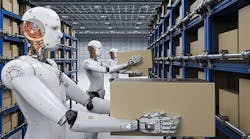Every year, in our annual MH&L Salary Survey, we ask readers to identify the biggest challenge they face in their jobs, and every year they tell us the same thing: finding, developing and retaining talent. It’s one of those nagging dilemmas that just doesn’t seem to have an answer.
That’s why we went to the experts—the members of the MH&L Editorial Advisory Board—and asked them to weigh in on that subject, and on several other of the most pressing concerns to supply chain professionals. Whether the topic is talent, technology, or Trump, one thing our board members all have is an opinion, and they come by their credentials the old-fashioned way: through their long and storied careers in all facets of the supply chain.
Participating in the 2018 roundtable (in alphabetical order) are:
● Roger Bostelman, engineering project manager, Intelligent Systems Division, National Institute of Standards and Technology (NIST)
● Tan Miller, director of the Global Supply Chain Management Program, Rider University
● Alex Scott, assistant professor, Supply Chain Management, Northeastern University
● Jim Shephard, president, Shephard’s Industrial Training Systems
● David Sparkman, founding editor of ACWI Advance and head of David Sparkman Consulting
● Jim Tompkins, CEO, Tompkins International
● Al Will, president of PWG Distribution Solutions
NOTE: Ron Giuntini also participated in the roundtable, but his contribution on the servitization trend will appear in a separate article.
Automation, Robots and AI
MILLER: One ominous, fearful thought that lurks under the surface of a discussion of robots, automation and artificial intelligence is the “human question.” Namely, what are the implications for employment and future workforce requirements of these advances? In the world of economics, articles abound regarding the controversial issue of whether in the future the U.S. and other countries will need a “government guaranteed income” for all working age citizens. Proponents of this initiative argue that in the future, the combination of robots, automation and AI will so dramatically reduce the need for workers (and create high permanent unemployment levels) that at some point, we will have to adopt some minimum level of guaranteed income for all working age citizens. Unemployed workers displaced by technological advances in automation would receive this guaranteed income. And discussion of this concept is considerably more advanced in some European countries than in the U.S.
While not disputing the significant current and future employment ramifications posed by technological advances, let me offer several admittedly unscientific, anecdotal, employment-related observations based on several decades working in and studying logistics and supply chain management (SCM):
1. The use of mathematical optimization models to provide decision support for SCM activities ranging from strategic planning to daily production and transportation scheduling now flourishes in private industry. Dramatic technological advances in both computer hardware and mathematical algorithms—some powered by AI techniques—have allowed commercial firms to embed these mathematical models deep within the bowels of their systems. Most SCM practitioners of these tools (e.g., transportation schedulers using your favorite commercial software systems) have and require no background or expertise in mathematical optimization modeling. Rather, SCM planners and schedulers understand how manufacturing, distribution and transportation networks work, and what types of plans and schedules their software tools must generate. This “understanding” of networks and logistics allows tens of thousands of SCM colleagues to perform state-of-the-art scheduling activities daily. Years ago this was not the case.
Firms that were early adopters of mathematical optimization decision support often had large operations research groups filled with experts in this field. These optimization experts would develop and run mathematical models to assist their firms’ scheduling and planning decisions. From the 1950s until the present day, however, technological advances in mathematical algorithms, hardware and software greatly reduced the need for individual firms to maintain internal operations research groups staffed by optimization and simulation experts. The evolution of “user-friendly” commercial software with embedded advanced mathematical algorithms dramatically reduced the need for internal mathematical expertise. In fact, by the 1990s, many firms had disbanded their once thriving internal operations research groups.
However, while technological advances over time decreased the need for internal operations research expertise, concurrent technological advances in user-friendly commercial software generated increases in firms’ demands for planners and schedulers who understood logistics networks and knew how to effectively employ user-friendly but advanced commercial scheduling software. So this is a case where technological advances reduced or displaced demand for labor and expertise in one area (internal operations research expertise), but over time contributed to a substantial increase in demand for expertise in another area (expert logistics planners and schedulers facile with commercial software).
2. In recent years, firms both large and small have launched new “Data Science” or similarly named groups. As the phenomenon of Big Data has taken hold in the private sector, many firms which as recently as 10 years ago devoted minimal resources to large-scale database mining and analytics have reversed course. The fear of competitive disadvantage and the promise of gaining competitive advantages through data analytics have stimulated enormous internal investments in labor (i.e., data scientists), hardware and software across industry. I personally know of several Fortune 500 firms today that have large internal data science groups which literally did not exist five years ago. Further, if one does a Google search on data science groups in private industry, numerous large industry groups formed just since 2007 appear. In short, the profession of data scientists has significantly expanded and blossomed in recent years, propelled by dramatic technological advances, including those in AI and automation.
It is impossible to predict with certainty how AI, robotics and automation will affect SCM employment opportunities and requirements in the future. Clearly advances in automation and robotics have and will continue to reduce or eliminate some SCM employment needs and opportunities. However, as the brief anecdotes shared here illustrate, new and different opportunities will also result from technological advances. From my perspective, embracing rather than resisting technological advances, and focusing daily on a continuous learning process and journey as a SCM professional represents the best path for navigating the rapidly evolving SCM landscape. Be part of the technological advances sweeping the SCM world—don’t resist them.
BOSTELMAN: In FY2018, I led the NIST Advanced Mobility Project for AGVs, mobile robots and mobile manipulators. The latest smart manufacturing concept that we developed and demonstrated is the robot-on-a-cart concept for autonomous assembly or conveyer tending. The cost-effective concept allows a single mobile base to tend to one or many carts that can have a variety of onboard items, including packages, materials, or even robot arms. For example, the NIST demonstration shows an assembly operation. The cart is pushed about by the mobile base, parked/docked at an assembly or conveyer-tending area, and removed from the cart to perform other tasks. At NIST, the robot-on-a-cart then begins an assembly sequence that can be measured for performance of the concept. Once the assembly operation is completed, the cart computer calls the mobile base to move the cart to a new location.
TOMPKINS: Sellers today find e-commerce inventory allocation and replenishment to be challenging. Managing SKU level eaches is very different from managing larger quantities. Sellers have a difficult time deciding which SKUs to locate where, and how to dynamically manage them in a changing marketplace where demand is uncertain. This problem starts with sales forecasting, which in e-commerce is even more difficult than at the store-level. The allocation of the right SKUs and volumes to different fulfillment centers has proven to be an excellent opportunity to apply AI. We’re seeing AI being used for more accurate demand forecasts, by near real-time machine learning on what is selling where and will likely continue. This is just one of the numerous AI applications for today’s complex uni-channel supply chains.
WILL: The future is the complete “lights out” distribution center utilizing both auto-loading and auto-unloading equipment at the dock. At MODEX 2018, I saw a robotic system capable of unloading a trailer packed with various sized boxes, and there was considerable interest amongst attendees. Another company is offering a telescopic conveyor equipped with sensors to load packages in a trailer without the need for a package handler in the trailer. Velocity is increased as there is no need for manual control of the telescopic and no loss of production due to scheduled work breaks by employees. As manufacturers continue to expand the various applications these systems can handle, we’ll see more firms designing lights-out facilities.
Drones & Autonomous Vehicles
WILL: Drone development over the past several years has resulted in a variety of applications and more recently use in the inventory and tracking of items in warehouses. The current limitation with drone technology use in warehousing is it’s only a two-dimensional scanner. It can scan (inventory) the face of a warehouse location opening but cannot count the product behind the product at the front of the rack opening. We’ll be watching this technology closely as drone manufacturers add capabilities necessary for various warehouse applications.
SCOTT: It was interesting to see Uber pull back from developing autonomous trucks. I think they realized that the highly-uncertain payoff to this technology is far off and dependent on unpredictable regulators as much as on the technology itself. I personally see a lot of value in autonomous vehicles in the future, but it won’t be soon, and startups like Uber are probably not the best type of firm to develop the technology. I think a more established, profitable company will be better suited to bring the technology to reality, which will be a long slog.
SPARKMAN: Several economists share my view of widespread adoption of autonomous trucks in the near future: Ain’t gonna happen. It will take years for them to be accepted by the public, while much of the safety technology developed so far is being incorporated into the current truck fleet driven by real people—assuming you can find someone to do that job.
Trump Tariffs and their Impact on Supply Chains
SPARKMAN: When I was a rapidly-maturing pre-adolescent, my mother set me straight on the facts of life.
I had seen an article in the newspaper reporting on the enormous amount of steel coming out of Hong Kong. “But isn’t Hong Kong too small to produce all that steel?” I asked in all innocence. Patiently, she explained that it was technically illegal to buy steel, or much else, from the People’s Republic of China (PRC), which we had yet to recognize. Instead the PRC exported through the then-British crown colony of Hong Kong, with everyone agreeing to pretend the goods originated there.
At that time—the mid-1960s—my mother worked as a researcher for a NASA contractor. Instead of using Google to search scientific literature, imagine hundreds of women using massive mainframe computers searching for physical documents based on key words submitted by scientists. She had seen reports of massive power plants being shipped in pieces from Hong Kong, which couldn’t have produced them.
I tell this story for a reason. President Trump’s tariff tear has many people in business worried about its negative impact on the economy. That may very well be true, but it ignores the almost limitless capacity of human imagination for chicanery. How many of us count among our ancestors rum runners and other smugglers, and the proverbial Yankee traders seemingly capable of conning almost anyone out of a buck? (See “Snake Oil” and “Trump, Donald.”)
Add to that the teeming mob of under-employed lawyers who can find their way around almost any law before its ink is dry. If you doubt take a look at what’s happened to all the campaign finance laws passed over the years.
This is a long way around to noting that most economic predictions these days are always accompanied by the caveat “…as long as tariffs don’t cause too much damage,” a common refrain among industry association economists in their presentations at the American Trucking Associations Annual Economic Summit held in September. They also agreed that the currently hot economic growth trend will cool down but not reverse its advance next year. GDP growth is expected to continue into 2019, but just not as fast as it has this year.
SCOTT: Obviously tariffs, if implemented for the long-term, will impact global supply chain strategies—sourcing, nearshoring versus offshoring, etc. It is difficult to know, however, how long these tariffs will last, as they very plausibly are negotiation tactics being used by President Trump. So I’d be surprised if companies are changing their long-term, major investments much based on the recent tariffs. I’d bet most are taking a “wait and see” approach.
Finding, Developing and Retaining Talent
SHEPHARD: It has been a while since I last offered comments concerning something so important as people, training and workplace safety. Although we have been in the consulting and employee training profession for the past 32 years, we have never seen such demand for comprehensive training for not only new hires, but existing company employees as well.
Technology has raised the bar and a new workforce is knocking at the door, bringing with it zero if any experience, minimal skills, below the acceptable level of motivation, and unbelievable work ethics (good and bad). On this subject, meeting with numerous safety managers, human resource managers and facility managers, the question always circles back to, “How do you overcome, inspire, motivate, and make real teammates out of this new wave?”
Across the board, from fast food to manufacturing, what we are hearing, to put it into simple terms, is an over-the-top request to develop and implement site, equipment and task-specific training programs. I’m not trying to sell a concept, but let’s get serious, you do have a choice. The workforce is out there, but you are going to have to develop skilled employees that will pay attention to detail, take care of equipment, participate in company business, ensure quality in all facets of any process, make sure production schedules are met, help control cost, and last but not least, motivate them to show up for work.
From discussions with one of our clients, we agreed as to what would help them solve their problems: they had to develop and implement a new, more detailed, and comprehensive new employee orientation program, in addition to developing and implementing work-specific training programs that targeted the many tasks, the environment and the equipment. How did they do it? They captured talent, knowledge and skills from their existing workforce before they retired. What did they do? They developed a consistent method to train employees, then they assigned key individuals as mentors. This helped eliminate frustration for the new teammates and prevented bad habits from continuing to be developed among the workforce.
What’s the answer? First off, don’t be so naïve to think that because you know and understand the process, that they (the workforce) will understand their requirements. Start by administering a pre-employment exam! Next, get ready to weed out those that do not meet the requirements, and then develop an in-house training task team and establish an in-house trainers’ network using trainers who have the skills, knowledge and experience to develop and implement your company’s task-related training programs.
Let’s be truthful, this does not sound practical, but some are already well on their way. Are you still floundering around with last year’s problems? The question is, what is it costing your company for not meeting customer demands due to in-plant problems. Remember the old saying, “You can pay me now or pay me later.” A small investment in your employee assets will go a long way in meeting customer demands and retaining talent. Hey, from the cheap seats, most of our clients don’t see any other way. Education is the answer. Oh, by the way, this should not be one of those programs that once implemented you can penny pinch tomorrow’s training. Once in, you’ve got to stay the course. But if you have an old-school mentality about this, you’d better have a serious talk with yourself. Get with the program, capture the skills, share the knowledge, and turn the corner. Remember, developing talent and keeping talent takes TLC, but workplace safety is the byproduct of your training efforts.
TOMPKINS: A day does not go by without us seeing a story on the shortage of qualified workers. The positions most frequently mentioned include truck drivers, warehouse workers, machinists, engineers, teachers, accounting, sales, IT staff, nurses, and more. Instead of fighting this losing battle, what we must do is deploy machines to take over or support these labor needs. For example, for truck drivers we need to move forward with autonomous vehicles, for warehouse workers we need to pursue robotics, for machinists we need automate the appropriate machinist tasks. The answer is not more pay, more time off, buying foosball tables, or free coffee. The answer is to replace human operators with machines. The sooner we grasp this reality the sooner we will get onto a real solution that solves the underlying problem.
Exoskeletons
BOSTELMAN: Exoskeletons are now a global technology thrust. At last count, there are nearly 60 exoskeleton developers around the world. With such high interest in this technology, NIST sees an opportunity to support the industry with measurement science and standards.
I lead a new NIST project called “Standard Test Methods for Exoskeletons” that has gained an amazing foothold in this industry. Exoskeletons are being marketed for commercial/recreational, medical, military and industrial applications. The problem is that there are no commonly-accepted measures of performance whatsoever in this field. The measurement science required is very complex due to the fact that exoskeleton designs vary widely. Even the most basic question, “will this device do no harm?” cannot be answered.
The NIST project objective is to develop measurement science to underpin the design of safety and performance test methods for exoskeletons worn by humans for industrial applications.
In this past year we designed and developed a new test method system called Position and Load Test Apparatus for Exoskeletons (PoLoTAE) that allows exoskeleton manufacturers to compare their wearable device to the task. At NIST, we began an Internal Review Board Study to test the PoLoTAE on 180 subjects (30 subjects performing tests on six different PoLotAE tasks). Already, the PoLoTAE has been requested to be replicated by several exoskeleton users and a manufacturer.
The design and development of a new measurement method to compare the exoskeleton fit to the body – beginning with the leg. The method uses a NIST-designed artifact, optical tracking, and an analysis method. This method is also a part of the IRB study to test it on 30 people.
Blockchain
MILLER: Whenever the subject of blockchain arises, I invariably think of RFID. There are a number of striking parallels between the two.
First, both are/were talked about as transformative technologies when they first began receiving attention. And both technologies had existed for a number of years prior to bursting into prominence. In the case of RFID, Walmart’s 2003 edict to its top 100 suppliers that they implement RFID technology by 2005 propelled the technology into the spotlight. In the case of blockchain, the rise to fame of “bitcoin,” an alternative currency reliant on this IT technology, significantly increased the interest in, and visibility to employing this technology in fields such as supply chain management (SCM).
Second, despite the initial hype surrounding both technologies, clearly the gestation period for both between introduction and substantial deployment across industry was/will be lengthy. (RFID remains even today a technology that while some firms have utilized effectively, many others still have yet to invest in and commit to using.)
Third, the paths from initial projected applications to established large-scale, practical applications were/will be far from linear. The current exploratory work, debates and prototype “use cases” underway in the SCM industry on blockchain remind me of similar efforts 10+ years ago on RFID.
What can we learn from the parallels between RFID and blockchain? If your firm is not currently on the leading edge of blockchain exploration, investment and/or prototyping, you are not in a significantly disadvantaged competitive position.
On the other hand, if your firm has no plans to carefully monitor the progression of blockchain over the next several years, the risk will steadily increase over time that you will fall behind competitors or miss potential opportunities to improve the efficiency and effectiveness of your supply chain.
The good news is that “carefully monitoring” the progress of blockchain does not require an immediate major financial investment. One to a few key trusted SCM professionals in a firm can carry out this “monitoring process” by attending appropriate industry conferences, participating in industry blockchain advisory groups and so on.
One final thought: Actively monitoring and evaluating the progress of a relatively new technology can lead to unexpected and important findings and benefits. For example, in the flurry of corporate initiatives triggered by Walmart’s RFID edict in 2003, several firms reported that in their efforts to meet Walmart’s RFID requirements, they actually developed related processes that improved their inventory accuracy levels within their own (i.e., within the suppliers’) warehouses.
Omni-channel Distribution—Have Retailers Figured It Out Yet?
TOMPKINS: The way the question is worded sheds light on the topic. However, before I pursue this line of thought let me answer the question. Background needed for the question is to look at what came before omni-channel, namely, multi-channel. Multi-channel came to pass as a result of retailers pursuing multiple channels, but not necessarily doing so methodically. There were real battles with multiple channels fighting over turf. The battle focused on the financial accountabilities for the different channels. The result of multi-channel was to build firewalls between channels and to produce clear, accurate financials.
In addition, separate channels often have separate information technologies that do not integrate well. Thus, all companies were challenged with “distributed orders,” which drove them to needing a distributed order management (DOM) solution. Any activity cross channel was discouraged.
What became clear was a lot of duplicated functions and the organization did not perform well. The area of most waste was inventory. Companies found themselves out-of-stock in one channel and overstocked in another. They found their ability to allocate inventory to channels to be not only inefficient but also ineffective. The result was companies realized they needed to work together as one with omni-channel.
Omni-channel begat sharing sourcing, procurement, allocation, deployment, inventory, and yes in many cases, distribution. The focus of omni-channel was to operate several channels from an inventory perspective as one. For the most part organizations quickly got together on the sourcing, procurement, allocation and deployment. What did not come as easily, however, was the physical sharing of inventory and locations. The challenge with sharing inventory and distribution came from the differences of distribution to stores (cases) and fulfillment to consumers (eaches) and the in place distribution centers and fulfillment centers.
I clearly recall in 2001 working for a toy retailer where the store selling unit was the four turtles to a set (Leonardo, Donatello, Raphael and Michelangelo) but online they sold each turtle as a sales unit. Therefore, the first step for online fulfillment was to open the sealed packs of four turtles and separate them into the four individual warriors (Leo, Don, Ralph and Mike).
In addition to how they were sold omni-channel also had to overcome the challenge that separate facilities and 3PL contracts existed for distribution versus fulfillment. Nevertheless, these issues have been getting resolved and the answer was 80% of the retailers figured it out.
But then, things got more complex as buy-online-pickup-instore, buy-instore-and-deliver-to-consumer, buy-online-deliver-to store-for-delivery, etc. Also, what really got complex was the voice of the customer that said, “I want to buy it where I want to buy it, receive it where I want to receive it, and return it how I want to return it.” The customer said, “I want a seamless shopping experience and I want an engaged relationship.”
This is beyond omni-channel; this is the unification of the channels. This is uni-channel. This is an integrated customer journey; this is the standard of today. Therefore, I believe a better question is, how are retailers doing on uni-channel? Unfortunately, only 20% of the retailers understand this, as there is more work to be done. We really need retailers to go beyond omni-channel and become uni-channel.
Electronic Logging Devices
SCOTT: It will be interesting to see the impact of electronic logging devices (ELDs) on the composition of the industry. My reading of what’s gone on so far is that they haven’t had the negative operational impacts that some were predicting, and that some firms are taking advantage of the additional data they get through the ELDs. Having analyzed inspection data from the FMCSA, it’s clear that small carriers are now complying with Hours-of-Service regulations at a much higher percentage. Whether this reduces accidents, however, remains to be seen, and this was the main justification for the ELD mandate.
Dimensional Weight Pricing
WILL: Shippers using standard boxes where 50% or more of the volume is air will need to start implementing new equipment capable of making the right-sized corrugated box for the product being shipped. With high-speed measuring and weighing equipment readily available, the exact dimensions and weight of the product being shipped can be transmitted into machines capable of cutting the corrugated box from stock material. Personnel in the shipping department will no longer need to make a decision on the size of box to use for shipping a parcel. The exact fit box produced by the machine will have a barcoded label used to marry the box with the parcel to be placed in it. Call it a just-in-time shipping box. The savings resulting from this technology is reduced shipping costs, reduced labor hours in the shipping department, and reduced cardboard requiring recycle.
Last-mile Delivery
TOMPKINS: As I stated last year in the 2017 Editorial Advisory Board roundtable, I do not like the phrase “last mile.” I prefer the phrase “final delivery.” “Last mile” is often not the delivery of a package to a location one mile away, but rather the delivery of a package to a location hundreds or even thousands of miles away. There is also the growing issue of the “final 50 feet” (where exactly to place the package).
The thing we know about final delivery in e-commerce is the delivery must be quick and inexpensive. Unfortunately, final delivery choices are often fast and expensive or slow and inexpensive. With the customer wanting fast/inexpensive and the options given are fast/expensive or slow/inexpensive, what can we do? The answer lies not only in how you deliver, but also in how far the delivery is.
It is clear after doing hundreds of network studies that the traditional approach begets a minimal cost network, but not a maximum profit network. Recent research proves that the quicker a firm delivers, the more they will sell. Therefore, the key is for final delivery to be quick/inexpensive.
Companies must implement a distributed logistics network where they can locate inventory in multi-client, automated fulfillment centers that are close to the customers. Trying to solve the “last mile” or “final delivery” via a traditional network is folly. To really do this well, sellers must join a distributed logistics ecosystem.
The Regulatory Revolution
SPARKMAN: CEOs and economists I’ve heard speak over the past year share the view that the economic boom was driven largely by two things: tax reform legislation and Trump’s regulatory reform campaign. I find the latter fascinating because it had been conventional wisdom among those advocating heavier regulation that it really had little impact on the economy.
Of course, there are different kinds of regulation. Let’s get the “I told you so” out of the way quickly. Labor and employer restrictions may have lessened but as I predicted, federal safety and anti-discrimination enforcement remains as strong as ever. New wrinkles include regulatory changes wrought by the sexual harassment revolution and the steady advance of LGBTQ rights through the courts across the country.
I also warned earlier that many of states and localities would continue to build stricter regulatory schemes. This has been true in Blue states and cities, like New York (both the state and the city). The explosion of new business laws in California range from a proposal to fine waiters and waitresses thousands of dollars for handing customers plastic straws, to banning business and local police from cooperating with federal immigration enforcement. Also notable was last summer’s California Supreme Court decision almost eliminating the use of independent contractors in that state.
But enough about you. When our esteemed editor handed me this assignment, I said: “Gee, thanks. I get to predict what will happen politically just weeks before the mid-term elections.” Okay, here it is: We are definitely going to see a Blue Wave that will sweep the Democrats back into control of at least the House and possibly the Senate. Or we are going to see a Red Wave generated by a silent majority of Americans daunted by Democrats’ shameless shenanigans. Or things will stay pretty much the same.
Unfortunately, what we can be assured of is outright chaos if the Democrats do manage to take the House—especially if those candidates and current members who have called for impeachment of President Trump carry through on their threat. Even if the cries for impeachment are squelched, Democrat congressional leaders have repeatedly declared that with control of either body’s committees, they intend to embark on an endless round of hearings to investigate every aspect of the Trump Administration. This should not be doubted coming from a political party that following the last election chose to call itself “The Resistance!” instead of the loyal opposition.
And, why should they compromise with a bunch of racist gun nuts who hate minorities and women, want to close our borders to “undocumented workers” and refugees in need, and fascists who colluded with the Russians to steal a presidential election? On the other hand, how can anyone expect Republicans to compromise with a collection of amoral atheists who openly hate Christians, want to hold our borders open to tens of millions of “lesser breeds without the law,” seek to turn America into a socialist hellhole like Venezuela, and who colluded with the Russians in an attempt to steal a presidential election?
At this stage in our history, can you see these people getting together to agree on a new infrastructure program?










